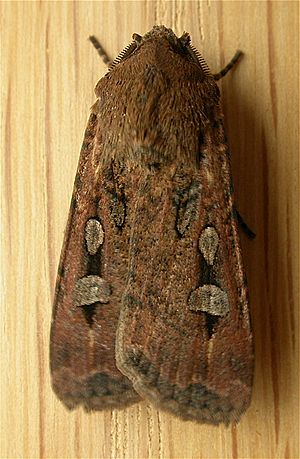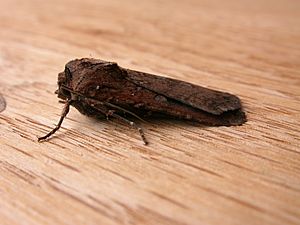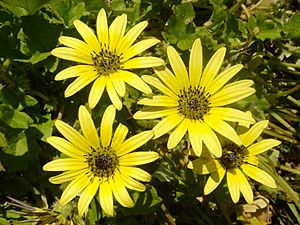Bogong moth facts for kids
Quick facts for kids Bogong moth |
|
|---|---|
 |
|
| An adult | |
| Scientific classification | |
| Synonyms | |
|
The bogong moth (Agrotis infusa) is a type of moth that flies at night. It is famous for its long journeys, called migrations, which it makes twice a year. These moths fly to and from the Australian Alps. It's a bit like the monarch butterfly, which also migrates, but the monarch flies during the day.
During autumn and winter, you can find bogong moths in southern Queensland, western New South Wales, and parts of Victoria, South Australia, and Western Australia. This is when adult moths lay their eggs. The young moths, called larvae, hatch and grow by eating winter plants.
When spring comes, the moths fly south or east to mountains like Mount Bogong. They gather there in large groups and rest during the summer. This resting period is called aestivation. In autumn, they fly back to their breeding areas.
The name bogong comes from an Aboriginal language. The Dhudhuroa word bugung means "brown moth," which describes the moth's color. Bogong moths are important in Australia because they were a key food source for Aboriginal peoples. These groups would meet where the moths spent the summer to feast on them and hold gatherings.
Recently, bogong moths have become known for accidentally flying into big cities like Canberra, Melbourne, and Sydney. This often happens because strong winds blow them off course during their spring migration.
Contents
What is a Bogong Moth?
Adult bogong moths are dark brown. They have a dark stripe on their wings with two lighter spots. This helps tell them apart from other moths. Moths that migrate have brown hind wings, while those that don't migrate have paler hind wings.
Bogong moths have a wingspan of about 40–50 mm (1.6-2.0 in). Their bodies are around 25–35 mm (1-1.4 in) long. An adult moth weighs about 0.326 grams.
Eggs and Caterpillars
Bogong moth eggs are shaped like a dome and have ridges. They are very small, about 0.7 mm (0.03 in) wide and 0.4 mm (0.02 in) tall.
When they first hatch, caterpillars are pale. As they grow and eat, they turn green with stripes and spots. Caterpillars can grow up to 50 mm (2.0 in) long.
Where Do They Live?
Bogong moths mostly live across southern Australia, west of the Great Dividing Range. There are both migratory (traveling) and non-migratory (staying put) groups of these moths.
Adult bogong moths lay their eggs in New South Wales, southern Queensland, and northern Victoria. The young moths grow up in these areas. In spring and summer, the moths fly south or east to the Australian Alps. You can find them in the Australian Capital Territory and the Bogong Mountains. Sometimes, strong winds can even blow them as far as Tasmania and New Zealand.
Breeding Areas
Bogong moth eggs and larvae are found in soils that mix themselves and in farm fields. Here, there is plenty of food for the larvae, both wild plants and crops. Many larvae in these fields can cause a lot of damage to crops.
During spring and summer, grasses take over these fields. These grasses are not good food for the larvae. Because of this, adult bogong moths fly south in the summer. They go to cooler places to rest until conditions are good for breeding again.
Resting Places (Aestivation Sites)
During their spring migration, adult bogong moths find cool, dark caves and cracks to rest in. They also use spaces under large rocks or inside fallen tree trunks. These spots are perfect because they have steady temperatures and humidity. This helps the moths avoid losing too much water while they are resting.
Permanent resting sites are usually high up in the mountains, at 1500 meters (4920 ft) or more. The biggest groups of moths are found on mountain tops like Mt. Gingera.
Life Cycle of the Bogong Moth
After returning from their resting places in autumn, adult bogong moths lay up to 2000 eggs in the soil or on plants. The eggs hatch in about 4–7 days.
The larvae (caterpillars) grow slowly through the winter. They reach their full size in late August to September, just before they migrate. Caterpillars are active at night, eating plants in their breeding areas.
They then turn into pupae in soil chambers, about 20–150 mm (0.8-7.9 in) deep. This stage can last 3–11 weeks, depending on the temperature. Pupae are shiny and brown, about 20 mm (0.8 in) long.
Adult moths come out of the soil and soon begin their migration. Adult bogong moths are active at night. In spring, they eat and fly south to rest for the summer. They are not ready to mate yet and don't eat much during this resting time. In autumn, they fly back to their breeding grounds, lay eggs, and then die.
How Bogong Moths Behave
What They Eat
Bogong moth caterpillars eat winter crops and wild weeds like cape weeds. They mostly eat plants that grow in winter. They have been seen attacking many farm crops, including Medicago species, wheat, cabbages, cauliflowers, silver beet, peas, and potatoes. However, the caterpillars avoid grasses.
Adult bogong moths drink nectar from flowers like Epacris, Grevillea, and Eucalyptus when they are breeding or migrating. They do not actively eat during their summer rest.
Amazing Migrations
Bogong moths make long journeys twice a year, traveling up to 965 km (600 miles). The spring migration starts in early September. They fly from the lowlands of Southern Australia south to the Australian Alps to reach their resting spots. They stay there all summer. In autumn, they fly back to the lowlands to breed, mostly in April.
Bogong moths use the same resting spots year after year. This is why some parasites have adapted to live there, waiting for the moths to arrive. The number of moths in each resting spot changes during the summer. Some moths die, and others arrive or leave to go further south or back north.
Bogong moths migrate at night. Scientists are still learning how they find their way over such long distances. They might use light to guide them. They may also use the Earth's magnetic field, similar to monarch butterflies. A study in 2018 suggested they use both the Earth's magnetic field and known landmarks to find their route.
Some bogong moths do not migrate. This happens in areas where conditions are always good, so they don't need to move to avoid harsh seasons. These non-migratory moths, like those in Tasmania, also become ready to mate faster than the migrating ones.
Grouping Together
During the spring migration, bogong moths gather in huge groups. You can find up to 17,000 moths in just one square meter (10.8 square feet) inside caves and cracks. These dark, cool, and humid spots are perfect for their summer rest.
The first moths to arrive take the deepest and darkest spots. Later moths squeeze themselves under the wings and bodies of the earlier arrivals. This close contact helps the moths keep their body moisture. If disturbed, the moths will briefly spread out, drop some waste, and then quickly return to their huddle.
Even though they are mostly resting, the moths do become active at dawn and dusk. They crawl around and fly out of their shelters. They might drink some water, but they don't mate or actively look for food during this time.
Delayed Development
Bogong moths can delay their development, which is called diapause. This helps them survive changing environmental conditions. While one generation usually makes both migrations each year, more generations can grow if conditions are good and temperatures are warmer.
Normally, a bogong moth would be ready to mate in about 50 days. But this is delayed because there isn't enough food for the larvae in the summer. During the hot summer, grasses that larvae don't eat take over the fields. To avoid this harsh environment, bogong moths delay their development. They fly to cooler places and rest until winter, when they return to their breeding grounds and their food plants start growing again. The food they eat during migration is used to build up fat for their long rest, not for development.
Ecology of the Bogong Moth
Who Eats Them?
Predators
Bogong moths are eaten by many animals during their migrations and resting periods. Birds like Little ravens, currawongs, and Richard's pipits gather to eat the moths as they leave their resting sites. Aboriginal peoples also used to look for these bird groups to find the moth resting sites.
Bats attack the moths when they fly at dusk. Foxes, bush rats, and dusky antechinus have also been seen eating the moths. The endangered mountain pygmy-possum relies heavily on bogong moths for food.
Parasites
Two types of tiny worms, called mermithid nematodes, can parasitize bogong moths during their summer rest. These parasites are spread through water. Young nematodes live in the dirt on cave floors. They crawl up to the moths through water trickling down the walls. Moths get infected when they drink this water after arriving in the caves.
After a few months, the nematodes leave the moths, causing the moths to die. The nematodes then burrow into the cave floor, grow up, and lay eggs. They wait there for the next spring migration of moths. It's unusual because these nematodes parasitize adult moths, not the larvae. Their life cycle shows how they have adapted to the bogong moths' migration, as they depend on the moths returning to the same resting spots.
Arsenic in the Environment
In 2001, after heavy rain washed dead moths out of a cave, the grass outside the cave died. Scientists found that the soil had very high levels of arsenic. The bogong moths were the source. Since moths don't eat at their resting sites, they must have absorbed the arsenic from their lowland feeding areas as caterpillars. Then, they carried it long distances to the mountains.
This is called bioaccumulation, where substances build up in organisms. Even though each moth has a small amount of arsenic, the huge number of moths in one area can lead to harmful levels in the environment. Arsenic has also been found in the waste of animals like the mountain pygmy-possum, showing that it builds up in them too.
Scientists are concerned that farming practices, especially old insecticides, might be the source of this arsenic. Because of these concerns, insecticides are no longer used to control bogong moths in cities.
Drop in Numbers
In 2017-2018 and 2018-2019, there was a big drop in the number of bogong moths in the Alpine caves. Usually, millions of moths cover the cave walls in summer. But in these two seasons, some caves had almost none.
Professor Eric Warrant from Lund University thinks this drop was likely caused by a lack of rain. Winter drought in their breeding areas meant there wasn't enough food for the caterpillars. He said that some caves still had thousands of moths, suggesting they came from different breeding grounds that weren't as badly hit by the drought. He believes they won't disappear completely but could become locally extinct in some breeding areas.
Other scientists are worried about the impact on animals that eat the moths. Bogong moths are a vital source of protein for wildlife, including the threatened mountain pygmy possum and other insect-eating mammals and birds. Euan Ritchie, a wildlife ecologist, noted that the Australian Alps are very vulnerable to climate change. When it gets warmer, these cold-adapted species have nowhere higher to go.
Bogong Moths and Humans
A Historical Food Source
Aboriginal peoples in Southeastern Australia historically used bogong moths as a food source. Groups would travel to the mountain tops to collect the moths. This was also a time for different Aboriginal groups to meet, strengthening their relationships as they gathered and feasted.
They would go into the caves and scrape the resting moths off the walls into nets and dishes using sticks. Once collected, the moths were roasted to remove their scales and wings. They were then either eaten right away or ground into a paste. This paste was made into "moth meat" cakes that could be stored and taken home. People said the moth tasted nutty, similar to walnuts or almonds. The bogong moth is a symbol of Australian wildlife because of its historical role as an important food and a meeting point for Aboriginal groups.
Recently, scientists found tiny remains of moth on a small grinding stone in Cloggs Cave in Victoria. This stone is about 2,000 years old. This is the first time insect food remains have been found on a stone tool anywhere in the world. The Gunaikurnai were one of the groups who traveled to the mountains for this high-fat, energy-rich food. Stories of these journeys have been passed down through their oral history.
Pests of Farm Plants
Bogong moths can damage farm plants because winter fields are their breeding grounds and food sources for their caterpillars. There have been reports of large numbers of caterpillars causing damage in New South Wales. They mostly harm plants in rich, black soil areas. Crops like Medicago species, wheat, cabbages, cauliflowers, silver beet, peas, and potatoes have all been attacked by bogong moth larvae.
Bogong moths are usually a minor pest in Australia, and their patterns are hard to predict. It's often not worth the cost to control them. However, if there's a very bad outbreak, insecticides might be used on the affected crops.
City Invasions
Millions of bogong moths have been blown off course during their spring migration. Strong winds push them into big cities like Canberra, Melbourne, and Sydney. A famous example was during the 2000 Summer Olympics in Sydney. Bright lights and noise in cities can also attract the moths.
Parliament House in Canberra is right in the middle of the bogong moth flight path. Lights from the building can trap them, making them seek shelter inside cracks, shadows, or even inside the building during the day. People have tried to get rid of them by turning off lights, covering attractive spots indoors, and using insecticides. However, using insecticides in cities has stopped due to worries about the environment.
See also
 In Spanish: Agrotis infusa para niños
In Spanish: Agrotis infusa para niños










